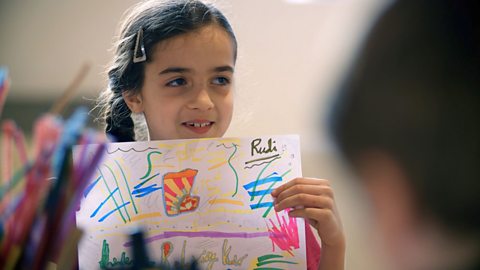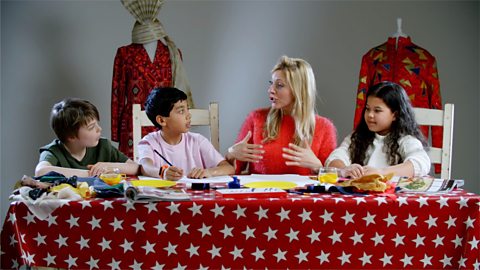Naomi: Hi! Oh what’s going on here?
Naomi: This isn’t right – I feel a bit peculiar!
Naomi: Well that was strange! Anyway, I’m here at this animation studio to set you a challenge.
Naomi: This studio is amazing – the team use their creativity to make models and produce stop-motion animations for a whole range of films and adverts.
Naomi: Stop-motion animation is when you take an object or a model like these and move them a tiny amount at a time - so I'm going to make this little mouse wave, so you would capture each movement with a photo.
Naomi: Then all those photos are pasted together by editors so that when you play them all back it becomes an animation that tells a story. Like this…
Naomi: It’s cool isn’t it? Right well I’m not just here to see the incredible things that these guys have done, I want to have a go at creating my own animation, and I know the perfect person to give us some tips!
Naomi: Nush is a BAFTA winning animation director.
Nush: There are a range of stop-motion animation techniques ranging from animating characters or models or even working with paint or drawings.
Nush: But my favourite things to animate are everyday objects, giving them character and personality.
Nush: What I first want to do is look at all the things I can move.
Nush: So lets say this peg- I'm thinking that its going to be a dog because it can move like this.
Nush: But then I'm thinking I need to make this into a thinking character because its only when you make it into a thinking character that you really bring out a personality.
Nush: So I'm thinking this dog wants to find something to eat.
Nush: So I'm going to get some tissue. If I do this action and I animate it so that the tissue slowly disappears while its munching on it, it will give the illusion that the peg or the dog is eating the tissue.
Nush: Another thing to remember that's very important when animating is sound. We've created a character and we've given it an action,
Nush: but when we put the two together and put a munching noise we then know that the character, the dog, is munching and eating the food.
Nush: So your challenge is to create a 30 second stop-motion animation using everyday objects you can find around your home or your school classroom.
Nush: Just remember to use sound to bring out the personalities and the characters. Be playful, enjoy yourself and get creative.
Naomi: Aw I love this challenge! So who’s going to be helping me on this one then?
Naomi: This is Piya, and her creative superpower is reading, because knowledge is power!
Naomi: Next up its Gabriella who has some amazing jazz skills!
Naomi: And this is Anushka, and she has a magic eye for colour and style.
Naomi: Right you three, are you ready to get started with our animation?
Children: YEAH!
Naomi: Good, lets get creative! You will need…
Naomi: A selection of everyday objects.
Naomi: Some sticking and fixing things to hold your objects in place, a tablet with a stop-motion app and tripod.
Naomi: First things first we need to decide what object we are going to use, so we've got a selection on the table, which would you like to use?
Gabriella: Chopsticks… I think we can make this into a mummy giraffe, and then this can be Jeffrey!
Naomi: Who's Jeffrey?
Gabriella: The little baby giraffe!
Naomi: So Jeffrey is a little baby giraffe!
Piya: I think we should use a cotton wool ball for the heads.
Naomi: I like that idea a lot, so we could have chopstick giraffe with cotton wool ball face!
Gabriella: And then he trips over that big marble.
Naomi: Jeffrey the baby giraffe trips over that big marble. Are we happy with that story?
Children: YEAH!
Naomi: Shall we try and animate it?
Children: YEAH!
Naomi: OK, pass the tablet! Fingers crossed!
Naomi: You can choose any object you like, just whatever you have lying around that sparks your imagination!
Naomi: Remember, you will need to take lots of photographs and make really tiny movement between each picture.
Naomi: Aw, poor old Jeffrey! Pleased with that?
Children: YEAH!
Naomi: Right, now its over to you! Get creating!
Naomi: Right, should we do another scene or should we pick a new object?
Children: Another object!
Naomi: Alright, lets do it!
Naomi: If you enjoyed this challenge there are loads more over on the BBC Teach website.
Naomi: You can write a poem, design a chair or even write a script for your favourite show.
Naomi: So go, on get creative!
Video summary
Presenter Naomi Wilkinson visits an animation studio and shows us how to create our own stop-motion animation.
When we watch animations, we might not always consider the work that has gone into creating the piece.
Animators use drawings, 3D models and everyday objects in their creations and stop-motion is an extremely accessible form of animation, for animators of all abilities and ages.
We meet Nush Kishani Naanayakkara, BAFTA-winning animation director, or as we call her, master animator.
Nush demonstrates how to plan and create a stop-motion animation.
She photographs inanimate objects as starting points for a simple stop-motion animation, and she shows how we can bring character to everyday objects using movement and sound.
Naomi and a group of children take on the challenge and working as a group they create a stop-motion animation of their own.
We see the result of their work and the short stop-motion animation they create.
This short film is from the BBC series, Get Creative.
Teacher Notes
Before Watching
Ask pupils to reflect on animations that they have seen and how they think animations are usually created.
Discuss what elements an animation usually has in it (i.e. a narrative or story and characters), making links to literacy knowledge.
You could ask your pupils to research and sketch some images of their favourite animated characters, exploring what the drawing (or model) of the characters tells us about their personality.
Discuss how animators use clothes, facial expressions and body language to show how a character is feeling and to convey a personality.
After Watching
Ask pupils to have a look at the options of everyday objects available to them and discuss the personality traits they would attribute to the items and why.
Have pupils work in small groups or pairs to move and photograph the objects.
Ensure the children move the objects in a way that will create a sense of motion when viewed as a finished sequence in the animation. This might take a little practise and trial and error.
Remind the children that this is part of the creative process.
Finally record sound to add real character to your story.
Master Skill
Turning an everyday object into a ‘Thinking character’.
Thinking Questions
- How do animators show the personality of characters in their animations?
- How can you re-imagine everyday objects, making them into characters that have personalities?
- What does the term anthropomorphize mean and why is it relevant to our work today?
- What is the narrative in your animation?
Supported Learning and SEN
As essentially a photographic activity this challenge is accessible to children who have difficulties with traditional drawing and painting.
If appropriate you may want to create groups of children with mixed abilities to carry out the activities, these groups may be working with or without adult support.
It might be useful to make a collection of potential objects for use beforehand, some children might find it helpful to explore the character development potential of a few objects before deciding on one for their animation.
Extend This Project
You could work on this over a number of lessons; first writing a short story or a sketching a visual storyboard then moving to the stop motion part of the challenge.
Instead of animating inanimate objects you could spend a few lessons modelling characters out of modelling clay, with a focus on how to form and join 3D shapes (check out the Cake Sculpture episode of Get Creative for some tips on how to do this).
In a music lesson, children could even write their own musical score for their animation.
You could also use this challenge to lead on from the Write Song Lyrics challenge from Get Creative and create animated videos to accompany the songs the children have written.
Curriculum Notes
This short film meets and extends the current national curriculum requirements for art and design at KS1 and KS2 in England, Wales and Northern Ireland and at 2nd Level in Scotland.
The film and lesson ideas will engage, inspire and challenge your pupils to explore their own ideas and produce creative work.
The film introduces children to high quality skills and knowledge in art and design. The challenge set supports children in becoming proficient in techniques including, but not limited to, drawing, painting and sculpture.
Through this series, pupils will be introduced to and inspired by a range of artists, craftspeople and designers, they will experiment, invent and create work that links to the work of professional creatives.
Cake Sculptures. video
Karim Zeroual introduces cake sculpting and sets a challenge to make your own cake topper.

Product Design. video
A group of children are set a creative challenge to design a prototype product.

Costume Design. video
Naomi Wilkinson goes exploring in the costume department and challenges us to design our own costume.
